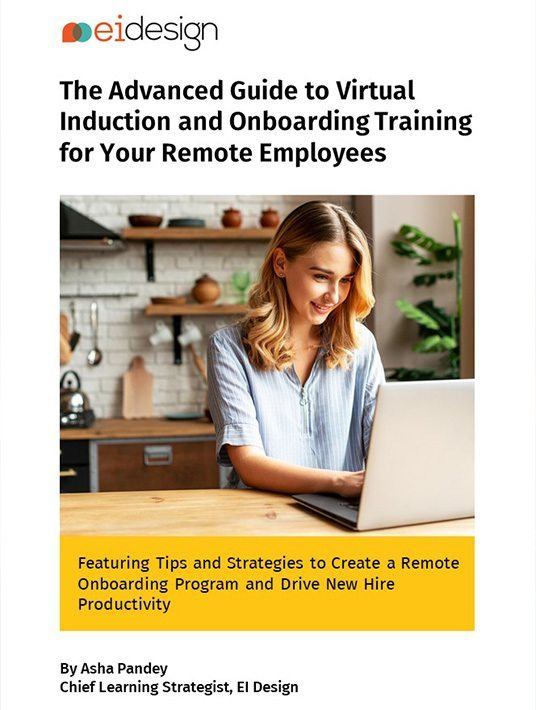eBook
The Advanced Guide To Virtual Induction And Onboarding Training For Your Remote Employees
by EI Design / Published: Oct 29 2020
What it's about
My eBook, The Advanced Guide To Virtual Induction And Onboarding Training For Your Remote Employees, provides insights that will help you handle the transition of moving face-to-face induction and onboarding programs to a virtual mode effectively.
Key chapters
-
How To Choose The Right Approach For Delivering Virtual Induction And Onboarding Training
This section begins with the aspects you must consider as you move to a virtual induction and onboarding program. It lists the challenges associated with inducing and onboarding remote employees—without human touchpoints. It also outlines two approaches to consider when moving the ILT induction and onboarding program to a virtual mode. It concludes by explaining why organizations are pivoting to blended induction and onboarding programs. -
What Tips And Best Practices Can Be Used For Virtual Induction And Onboarding Training
Even though we are facing a global pandemic, there is still a need to implement a strong induction and onboarding program for new employees. They may take the induction and onboarding sessions from their home or in a half-empty workspace, but the program must deliver the requisite value. This section lists out tips and best practices you can use to onboard new employees remotely in the midst of COVID-19. -
How To Promote Organizational Culture In Virtual Induction And Onboarding Training
In the conventional mode, organizations functioned with centralized corporate training centers where they carried out Instructor-Led Induction Training (ILT) to their new employees. This section outlines that in the changed workplace dynamics, blended learning is possibly the most effective approach to such training and how it can help reinforce the cultural norms expected from the new entrants. -
How To Shorten New Hire Time-To-Productivity With Virtual Induction And Onboarding Training
This section outlines how knowledge transfer and skills enhancement remain a key focus area of employee onboarding training. Time-to-productivity is one metric underpinning the success of such programs. The section includes several strategies and tips that can shorten time-to-productivity through virtual induction and onboarding training. -
How Mobile Learning Can Be Used To Create Effective Virtual Induction And Onboarding Training Programs
This section talks about how it is imperative to include mLearning (or mobile learning) in your virtual induction and onboarding training strategy with a majority of the new hires now working from home. It lists why mobile learning for induction and onboarding training is beneficial for both learners as well as the organization. It also includes learning strategies that can be used to create effective virtual induction and onboarding training programs. -
Case Study On Transition Of A Face-To-Face Induction And Onboarding Program To A Virtual (Blended 2.0) Mode
Induction and onboarding is an ongoing and recurrent activity for an organization on a growth path. This section showcases a case study on how we successfully transformed our predominantly classroom-based induction and onboarding program to a blended 2.0 mode.
Recommend this read to your friends and #shareknowledge!
Share
Get your copy now
Join other professionals like you, who have downloaded the eBook!
